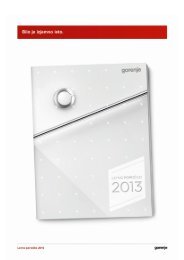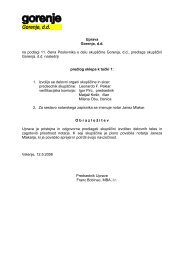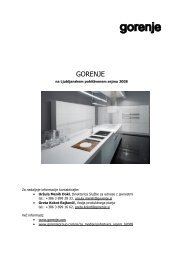Annual Report Gorenje Group 2009
Annual Report Gorenje Group 2009
Annual Report Gorenje Group 2009
You also want an ePaper? Increase the reach of your titles
YUMPU automatically turns print PDFs into web optimized ePapers that Google loves.
COMPANY - 3. SIGNIFICANT ACCOUNTING POLICIES<br />
The accounting policies set out below have been applied consistently to all periods presented in these<br />
financial statements, and have been applied consistently by the Company.<br />
a) Foreign currency<br />
Transactions in foreign currencies are translated to EUR (functional currency of the Company) at<br />
exchange rates at the dates of the transactions. Monetary assets and liabilities denominated in foreign<br />
currencies at the reporting date are retranslated to EUR at the exchange rate at that date. The foreign<br />
currency gain and loss on monetary items is the difference between amortised cost in the functional<br />
currency at the beginning of the period, adjusted for effective interest and payments during the period,<br />
and the amortised cost in foreign currency translated at the exchange rate at the end of the period.<br />
Non-monetary assets and liabilities denominated in foreign currencies that are measured at fair value<br />
are retranslated to EUR at the exchange rate at the date that the fair value was determined. Foreign<br />
currency differences arising on retranslation are recognised in profit or loss, except for differences<br />
arising on the retranslation of available-for-sale equity instruments, or a non-financial liability<br />
designated as a hedge.<br />
b) Financial instruments<br />
(i) Non-derivative financial instruments<br />
The Company initially recognises bonds and deposits on the date that they are originated. All other<br />
financial assets (including assets designated at fair value through profit or loss) are recognised initially<br />
on the trade date at which the Company becomes a party to the contractual provisions of the<br />
instrument. The Company derecognises a financial asset when the contractual rights to the cash flows<br />
from the asset expire, or it transfers the rights to receive the contractual cash flows on the financial<br />
asset in a transaction in which substantially all the risks and rewards of ownership of the financial asset<br />
are transferred. Any interest in transferred financial assets that is created or retained by the Company<br />
is recognised as a separate asset or liability. Financial assets and liabilities are offset and the net<br />
amount presented in the statement of financial position when, and only when, the Company has a legal<br />
right to offset the amounts and intends either to settle on a net basis or to realise the asset and settle<br />
the liability simultaneously. The Company has the following non-derivative financial assets: liabilities<br />
and receivables, and available-for-sale financial assets.<br />
Loans and receivables<br />
Loans and receivables are financial assets with fixed or determinable payments that are not quoted in<br />
an active market. Such assets are recognised initially at fair value plus any directly attributable<br />
transaction costs. Subsequent to initial recognition loans and receivables are measured at amortised<br />
cost using the effective interest method, less any impairment losses.<br />
Cash and cash equivalents comprise cash balances and call deposits. Bank overdrafts that are<br />
repayable on demand form an integral part of the Company’s current financial liabilities.<br />
176<br />
<strong>Annual</strong> <strong>Report</strong> <strong>Gorenje</strong> <strong>Group</strong> <strong>2009</strong>

















